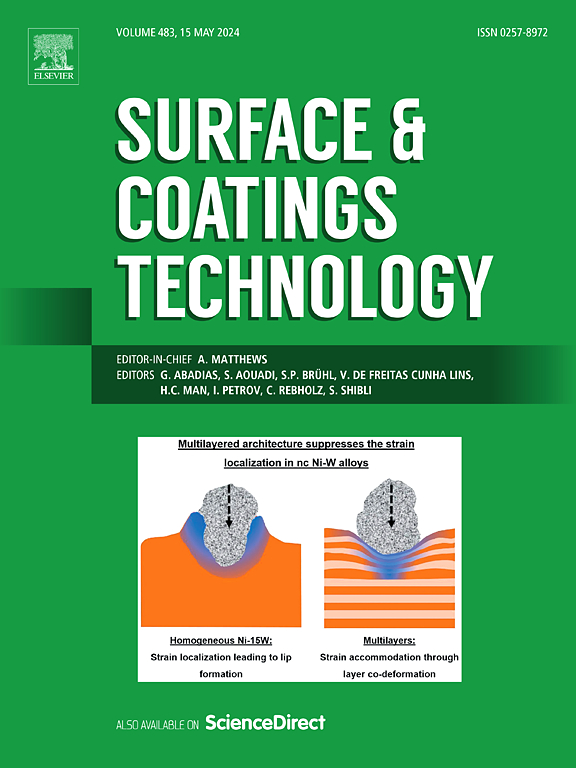A comparative study of thermodynamic and high-temperature tribological properties of ZrCN coatings and Ti60 substrate using first-principles calculations and experimental methods
IF 5.3
2区 材料科学
Q1 MATERIALS SCIENCE, COATINGS & FILMS
引用次数: 0
Abstract
To improve the mechanism and high temperature wear resistance of Ti60 substrate, ZrCN coating and Ti60 substrate were systematically studied by combining the first-principles calculation and double glow plasma surface alloying methods. The coating exhibited gradient changes in composition and structure. The hardness of the coating was determined to be approximately 17.4 GPa, about four times higher than that of the substrate. The interfacial adhesion strength of the coating reached 4.49 J/m2, corresponding to its good crack propagation resistance (CPRs = 385). The coating significantly reduced wear rates at high temperatures compared to the substrate, with values of approximately 7.7 × 10−5 mm3 · N−1 m−1 at 500 °C, 3.3 × 10−5 mm3 · N−1 m−1 at 600 °C, and 7.5 × 10−5 mm3 · N−1 m−1 at 700 °C, respectively. These improvements were attributed to the coating's good mechanical and thermal stability, including strong bonding strength, a low thermal expansion coefficient, and low Gibbs free energy. In addition, the formation of a tribo-layer and interlayer nitrides, consisting of ZrO₂, Ti₂ZrO, (Zr, Ti)O₂, and TiN phases at high temperatures, further enhanced its superior performance.
求助全文
约1分钟内获得全文
求助全文
来源期刊

Surface & Coatings Technology
工程技术-材料科学:膜
CiteScore
10.00
自引率
11.10%
发文量
921
审稿时长
19 days
期刊介绍:
Surface and Coatings Technology is an international archival journal publishing scientific papers on significant developments in surface and interface engineering to modify and improve the surface properties of materials for protection in demanding contact conditions or aggressive environments, or for enhanced functional performance. Contributions range from original scientific articles concerned with fundamental and applied aspects of research or direct applications of metallic, inorganic, organic and composite coatings, to invited reviews of current technology in specific areas. Papers submitted to this journal are expected to be in line with the following aspects in processes, and properties/performance:
A. Processes: Physical and chemical vapour deposition techniques, thermal and plasma spraying, surface modification by directed energy techniques such as ion, electron and laser beams, thermo-chemical treatment, wet chemical and electrochemical processes such as plating, sol-gel coating, anodization, plasma electrolytic oxidation, etc., but excluding painting.
B. Properties/performance: friction performance, wear resistance (e.g., abrasion, erosion, fretting, etc), corrosion and oxidation resistance, thermal protection, diffusion resistance, hydrophilicity/hydrophobicity, and properties relevant to smart materials behaviour and enhanced multifunctional performance for environmental, energy and medical applications, but excluding device aspects.
 求助内容:
求助内容: 应助结果提醒方式:
应助结果提醒方式:


